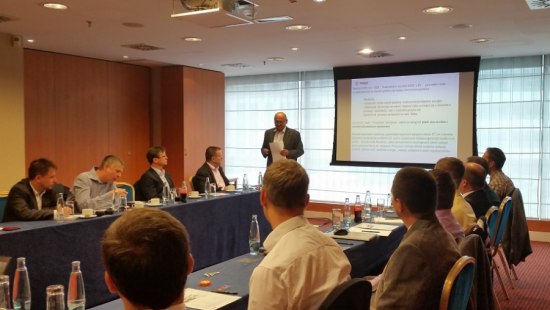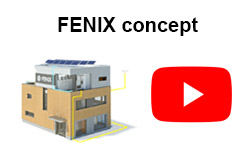A new energy concept – the Fenix test building in Jeseník

Ing. Cyril Svozil, Chairman of FENIX GROUP a.s., invited those interested in the project to meet and discuss it together. At the meeting, the concept for the building was presented, as well as the options for the testing stage of building operations. The Ministry of Industry and Trade, the Ministry of the Environment and the Energy Regulatory Office have all sent experts to the working group whose task will be the evaluation of obtained data. In addition, the Chairman of the Board of Directors of ČEPS (the Czech Transmission System Operator) has also shown interest in the information that will be obtained from the project. We are grateful that TZB-info has been invited to join this working group and that we have the opportunity to take part in the discussion about this new trend.
The aim of the project
The aim of the project is to evaluate the cooperation between a small roof-mounted solar panel system and home batteries in combination with the "smart grid" distribution network, and thereby demonstrate the advantages of this solution to the operators of energy networks, as well as users. The idea is to create the conditions for the appearance of a new tariff (buildings with home batteries). This will involve the batteries being charged under advantageous conditions from the grid when there is an energy surplus; at peak periods these batteries will then enable the completely or partially autonomous operation of the building. The construction of the new administrative building should be completed by May 2016. At the first meeting of the working group, Ing. Cyril Svozil asked the participants to propose model operating statuses.
Other information which concerns these issues will also be involved in the process. For example:
- From 1. 12. 2015, Decree No. 230/2015 Coll. is valid. It changes Decree No. 78/2013 Coll. on the energy performance of buildings, where (unfortunately) the expected adaptation of the coefficient for non-renewable primary energy didn't take place and the conversion factor of 3 remained valid. With regard to the requirements for the parameters of new buildings since 1. 1. 2015 and for nearly-zero energy buildings (state buildings and subsequently also other structures), it will be a problem for purely electricity-based heating that isn't offset by renewable sources of energy in combination with a building envelope of above-standard quality to get through construction proceedings.
- The management of the Energy Regulatory Office didn't approve the form that new tariffs will take at its meeting on 12th November 2015 – the final form of electrical energy tariffs will be determined after the evaluation of the public consultation process (a consumer "referendum"). The Energy Regulatory Office will present a new tariff system for electrical energy on its web pages in January 2016 at the latest and will publish the rules for the consultation process as well as a special section with a description of the main changes in the tariff system, and a comparative calculator.
The first meeting of the working group for the project
From Ing. Svozil's opening words:
- For electric heating ease of maintenance is important, as well as a maintenance-free lifespan of 40 years with only an electrical inspection once every 10 years – we expect the same level of convenience for the other elements in the system in this project.
- It is interesting to monitor the purposes for which electricity is used in buildings. The Energy Regulatory Office used to issue an overview about the use of tariffs, which was interesting for the market analysis perspective. It is clear from the last data available that the number of electricity customers who use electricity for heating is growing, but that only around 4000 consumers use the tariff for heat pumps.
- We see our project as a NEW CONCEPT FOR A NEW PERIOD, when this project will eliminate the current disadvantage to electric heating of electricity consumption peaks being covered by "dirty energy sources". The whole building will become an active part of the energy system. We are basically preparing for the year 2020.
- Elements of the system: In the past year, we have had negotiations with many producers of batteries and we have found many equivalents in the field of photovoltaics. Prices are decreasing by tens of percent year-on-year and the number of enterprises entering the market is increasing. We have to look for batteries with a sufficiently long lifespan so that we can obtain an acceptable rate of return.
- The delivery of the photovoltaic panels is important for us, and their quality is a priority as we know that the issue of photovoltaic panel defects is now topical in the Czech Republic. We will use Fronius SYMO HYBRID inverters which are intended specially for households and family homes. Our priority is not to obtain an island inverter but a hybrid one.
- We intend to set a precedent and open the way for this solution for existing buildings.
- Advantageous tariff conditions are absolutely essential. If the price conditions aren't sufficiently beneficial, support from the future "green light for savings" may also be an option. There must be financial savings which are perceptible also to users, as this is the only way to make them interested in the concept.
- The project represents a path towards the better utilization and safety of the whole distribution network.
Information was also provided by Ing. Jan Včelák, Ph.D. from the University Centre for Energy Efficient Buildings (UCEEB):
- The management of the system needs to be fine-tuned not only with regard to the production of electricity and the distribution grid, but also to electric heating. Proportional control will be needed, as well as adaptability to changing energy flows.
- UCEEB has a tool for the prediction of production from photovoltaic systems which allows us to predict the produced energy over a period of 48 hours, and this includes the safety coefficient. There will therefore be predictions available regarding how much electricity will be produced within the next 24 hours, and any predicted shortfalls can be prepared for by charging the battery from the grid.
- We have agreed on the monitoring and storage of data for a period of 2 years. This concerns individual appliances, the total flow of energy as well as the quality of the indoor environment (temperature, CO2...) as it isn't possible to merely look at the electricity meter. The building is constructed for people, not as a tool for saving energy, and its main job is to offer a comfortable environment for users.
"We will be happy if the working group can agree on the specification of the operating modes. The building is part of a production facility and will later function under real operational conditions within the framework of the whole complex. It will be possible to test the charging mode for 6 hours and the completely autonomous mode for 4–8 hours, or possibly even for a longer period," Svozil said, and in this connection emphasized the importance of cooperation with the Czech Technical University (UCEEB), an independent and respected authority on the monitoring and evaluation of data.
Source:
TZB-info / Electrical Engineering / Storage of Electricity
Date: 4.12.2015 | Author: Ing. Dagmar Kopačková, Ph.D., Editorial Office
http://elektro.tzb-info.cz/akumulace-elektriny/13528-novy-energeticky-koncept-testovaci-budova-fenix-v-jeseniku







